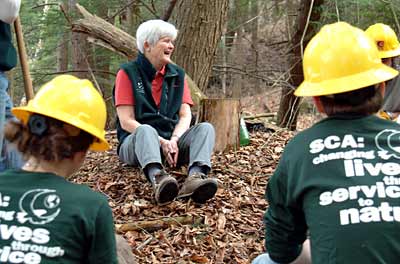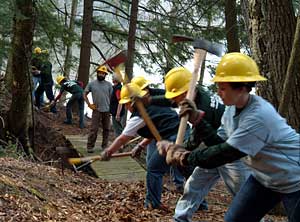Saving the Earth One Thesis At A Time
While my senior thesis—along with most of your, I imagine—is busy collecting dust on a long-forgotten bookshelf, Liz Cushman Titus Putnam’s ’55 just celebrated its 50th birthday. And it deserved the party. Putnam’s thesis outlined ideas that led to the founding of the Student Conservation Association (SCA), a nonprofit organization that has send 44,000 volunteers to conserve our national parks and other public lands since its 1957 inception.
In the 1950s U.S. national parks were literally being overrun, Putnam explained. Although the National Park Service was founded in 1916, it was only after WWII that Americans really began visiting the parks. But their unbridled enthusiasm put a strain on these natural treasures. Congressional funding was too low, and rangers were too few and too overworked. One proposed solution was to close Yellowstone, Yosemite, and other large parks and have their borders patrolled by the Army until adequate funds were appropriated to protect the Parks.
“They were being loved to death, but I felt that something better than closing them could be done,” Putnam said. So, during her freshman year while taking Vassar’s first interdepartmental conservation course, she learned more about the challenges of and need for conservation as well as the plight of national parks. Putnam focused her studies and later her senior thesis on addressing the “parks problem.” Departmental restrictions at the time prohibited Putnam’s wish to pursue an independent major in conservation. However, she found an ally in her faculty adviser the late Professor and Chairman of the Geology Department Dr. A. Scott Warthin Jr. Warthin offered to be her thesis adviser within his department, and he gave her the flexibility to take courses among various departments supporting her academic and conservation interests. As Putnam said, “It is impossible to describe accurately how vital Scott’s help and faith in me as a student was to my being able to create my thesis.”
Putnam’s thesis proposed matching up volunteers with conservation projects that the national parks’ budget couldn’t cover. Putnam was inspired by the New Deal’s Civilian Conservation Corps, and saw her project as a modern-day version. She believed that it could benefit the volunteers as well as the parks. “There were very few volunteer opportunities for young people at that time. This was a win-win: the students would experience the benefits of giving of service and giving of self, while the Park Service—and the public lands entrusted to their care—received greatly needed labor,” she said.

Putnam continues to be a source of inspiration for SCA volunteers nearly 50 years after founding the organization. She regularly visits crews in the field, speaks at SCA events, and hosts traveling SCA alumni at her Vermont home.
Armed with her thesis, and that “fortuitous Vassar network,” Putnam met Horace M. Albright, who with Stephen Mather had established the National Park Service and was a former director of the National Park Service. (The Vassar network: Putnam’s cousin, Elizabeth Beach Jones ’41, was good friends with Bertha Mather McPherson ’28, goddaughter of Albright.) Albright liked Putnam’s concept and suggested she visit some parks that summer (at her own expense, of course) to see if those in the field thought student volunteers would be helpful. Olympic and Mt. Rainier National Parks were chosen, along with Yellowstone and Grand Teton. Meanwhile, Warthin put Putnam in touch with Martha Hayne Talbot ’54, who joined her on this explorative trip to the four national parks. “Marty’s enthusiasm, dedication, friendship, teamwork, support, belief in the concept, and tireless energy were crucial to the positive outcome for the program in those early years,” recalled Putnam.
Superintendents and staff at both Olympic and Grand Teton wanted to give the concept a try, and by the summer of 1957 trial projects were up and running in both parks. There were 53 volunteers ranging in age from 15 to 52. Today the Student Conservation Association places about 3,500 volunteers in positions each year working on public lands—not only with the National Park Service but with many other federal, state, and local agencies as well. There are now more than 40,000 alumni of the program who have come from all 50 states, more than 30 foreign countries, and all walks of life.
“The opportunities SCA offers the participants are amazing—from A-Z, including Global Positioning Systems, fire education, trail work, and studying and working with endangered species from Maine to Hawaii to Alaska, as well as some international placements.” And SCA’s records show that more than 60 percent of SCA interns (many of them also Vassar graduates) have entered the conservation profession.
In the summer of 2001 Cara Klajbor ’04 worked in the Sandia Mountains, part of New Mexico’s Cibola National Forest. She worked on increasing park users’ awareness about the importance of paying their parking fees, by explaining what they were used for—maintaining recreational spaces. Because there were many wildfires in the area that summer, SCA volunteers were especially needed, Klajbor said. She patrolled the parks to make sure people weren’t cooking in blocked-off dry areas, made new trails, tracked bears with a wildlife biologist, and built a fence with a group of Native American firefighters from Oklahoma. After graduation she remained dedicated to SCA’s “giving of service, giving of self” mantra, though she’s now more focused on people than bears: she works with AmeriCorps at the Sacramento Child Abuse Prevention Council.
Taylor Ellis ’02 joined SCA after graduation to survey threatened and endangered species (concentrating on Mexican spotted owls) in the Sacramento Mountains of southern New Mexico. Today, he is a wildlife technician for the Mendocino Redwood Company in Northern California, again surveying spotted owls. “This is my third year doing spotted-owl work … but now I’m paid,” he said. “I also do other wildlife work, largely through connections I met during the SCA experience.”
Heather Cole ’02 also worked with SCA after graduating. She researched, designed, and led a tour at the Oregon Caves National Monument, with an environmental focus. “Basically the thesis was, Damn pretty cave, eh? Cool science, no? Here’s all the things humans can do to ‘crudify’ this and other parts of the environment. Now you don’t want to be responsible for filling this place with muck and all the wrong bugs and plants, right? Thought so,” Cole said.

SCA volunteers conduct spring trail maintenance along the Connecticut River in New Hampshire.
After 50 years, Putnam is still active in SCA, participating in Board of Directors meetings, sitting on committees, as well as visiting volunteers in the field. Putnam is working in her own community in southern Vermont to engage young people in a SCA-inspired, community program. Putnam has received many honors for her dedicated work, including from the President of the United States. However, one of her most cherished awards is from the National Park Service, who designated her as an Honorary Park Ranger and was given a Park Ranger hat. In 1987 Putnam received the Commendation Award; her teammate, Martha Talbot, the Conservation Service Award; and Professor Warthin, the Public Service Award, all from the Department of Interior. Putnam was thrilled when Warthin was recognized for his role as an inspirational teacher and as a supporter of Putnam’s work, showing other faculty what incredible and long-lasting, positive influence a teacher can have on his or her students.
For Putnam, the parks will always need more work, more attention. “Even with all the work that has been accomplished, there are still incredible problems and setbacks,” she said. “The parks are still grossly underfunded and thus undermanned.”
Bridget Deemer ’04, an SCA alumna who plans to return to a new project later this year, said she is concerned that environmental policies are suffering “across the board” and that recently released 2006 budget shows another decrease in parks spending.
“The parks should not be underfunded,” said Putnam. “They are one of the greatest gifts our country has. These magnificent parks have been entrusted to our care for future generations. They should be cherished, cared for, and protected.”
After dedicating more than 50 years to the national parks, she cares for them all, and can’t pick a favorite. “Each park is so special, has its own unbelievable beauty and unique qualities,” she said. “The Tetons I’ve known since childhood—have hiked, camped, canoed, and ridden in many of its special places; Cedar Breaks is one of the crown jewels of the parks system—in the spring, the wildflowers there are extraordinary. And I’ve always adored Olympic for so many reasons, including the fact that it has had the longest, continuous relationship with SCA. Oh, I could go on and on.”
Putnam rests a lot of hope on future generations. “It’s so important to inspire students to go after their dreams, to do something. That’s why I feel so strongly about Vassar,” Putnam said. “Vassar pushed me to do things, and from what I can see, it’s continuing to do so today. A wonderful example is seeing Professor Warthin’s legacy develop into the interdisciplinary Environmental Studies Program—that is so positive, and a great opportunity for the young people today. Empowering America’s youth to take charge of their future is the best way to make our world a better place.”
Veronika Ruff ’01 is studying international affairs and journalism at Columbia University’s School of International and Public Affairs.
To learn more about SCA visit www.thesca.org or call 603.543.1700. To read Putnam’s original senior Vassar thesis, click here to download a .pdf version of the document.
